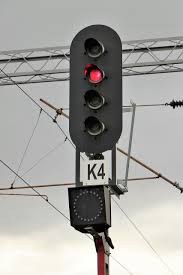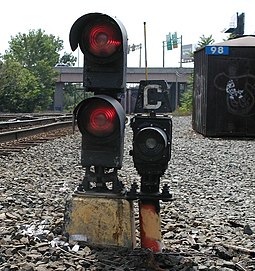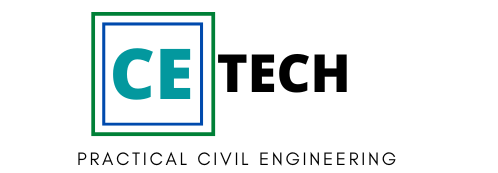Railway transportation is a critical mode of transportation for people and goods worldwide. Trains offer an efficient, fast, and safe way to move cargo and people over long distances, but they must be controlled properly to ensure their safety. Why? That is because trains move at high speeds and their wheels are smooth which lack traction for achieving less power in transporting large loads. This makes it necessary to have a long braking distance that can be 2000m. Therefore traffic control systems are essential in ensuring safe and efficient train travel. These systems involve signaling technology, which is responsible for ensuring that trains can run without risking collision or derailment.
In this blog post, we will explore the importance of railway signaling technology and its critical role in controlling train traffic.
Why railway signalling technology is important?
There is a difference in signaling in railways from that is performed in roadways. In railway signaling, the driver must be informed of an upcoming speed limit well in advance by pre-signaling signposts. The planning of meetings with other trains and overtaking cannot be handled by the driver on railway tracks. Apart from roadways where the driver handles the movement along the highway, in the case of railway lines, It must be done by a special traffic controller – the train dispatcher. The train driver is required to drive the train safely following the signaling information, safety, and speed instructions.
Railway signaling plays a pivotal role in the control of train traffic because:-
1. It ensures that trains can run without risking collision or derailment
2. It facilitates the locking and checking of switches in the correct position
3. It provides information about locking and checking of track barriers in the correct position
4. It makes sure that the track on which the train is to run is clear of obstacles
5. It makes sure that the road protection facilities at the level crossing are activated
6. It conveys a run message to the train when the track is safe and free of obstacles.
7. Ensure that no other train is allowed to enter the same track as train safety is based on the concept of blocking.
What is Signaling Technology?
Signaling technology involves a series of technical systems and procedures designed to ensure safe and efficient train travel. It aims to control the movement of trains by locking and checking switches in the correct position, checking that the track on which the train is to run is clear of obstacles, and conveying a run message to the train. Signaling technology also ensures that no other train is allowed to enter the same track, protecting the safety of the passengers and cargo onboard.
Signaling technology plays a critical role in ensuring the safety of railway transportation. Trains have a very long braking distance, making it challenging to stop quickly in the event of an emergency. The contact surface of a railway wheel against the rail is small, making it easy to slip when accelerating and easy to lock the wheels when braking. Trains cannot turn and can only overtake or meet at places with switches and multiple tracks. Hence, signaling technology is required to control train traffic and prevent collisions.
The History of Railway Signaling Technology
In the railway’s infancy, everything was managed manually. The position of the switches was checked by special railway inspectors who were posted at the switch and prevented it from being repositioned by someone unauthorized. Trains were permitted to move using a signal with a flag or semaphore. There was no technical barrier, which means the system is workable but individuals that bear responsibility can make errors. Safety was based entirely on everyone involved following the regulations, which led to several accidents.
Gradually, technical systems were introduced to take over more and more tasks that were previously handled manually. Today, automatic signaling systems employing track detection circuits control whether a track section is free or occupied. A switch that often needs to be repositioned is controlled and checked by a switch drive. The system that controls the operation of signals and positioning of switches or points is called interlocking. Interlocking systems make the signals show green only when the track is free of trains and safe, the switches also are ensured to be positioned to allow trains to move in a particular planned route. All other trains in opposite directions and trains approaching from other routes are stopped until the preceding train reaches a safe distance.
Interlocking systems have developed from early mechanical to electromechanical and then to electrical or relays and now modern interlocking systems are solid-state interlocking systems that are computerized and use specific interlocking software.
A signal can only show a green light if the track is free and the switch gears are positioned correctly. The signal’s message is transmitted wirelessly to the train’s train protection system (ATC), which brakes if the driver fails to do so.
Types of Signaling Technology
Information is conveyed from the signaling system to the trains using: Optical signals and Cab signaling.
Optical Signals
Information is conveyed from the signaling system to the trains using optical signals, which include main signals, pre-signals, and dwarf signals. Main signals convey a message that applies to the signal, while pre-signals give information about what the next main signal will show. Dwarf signals regulate switching movements.
Cab Signaling
Cab signaling is a safety system that uses signals directly visible to the driver in the cab. It provides the driver with information on the speed and location of the train, as well as the distance to the next signal. Cab signaling enhances safety by enabling the driver to respond quickly to any changes in the train’s environment.
Types of railway tracks
Railway tracks are divided into stations and lines. Stations are delimited places where the sequence of trains can be changed. The signals and switches in stations can be controlled by a train dispatcher
Lines are tracks that are situated between two stations. These have normally no switches and signals work automatically. The signals work automatically by the use of track circuits and blocking.
Stations are operation areas of railway tracks that are controlled and supervised by a train dispatcher. These consist of two categories of tracks and signaling objects:
1. Main tracks ‒ Intended for train journeys (and switching)
2. Side tracks ‒ Intended for switching only ‒ Signals are normally absent
3. Signals and signaling objects
Interlocking Systems and Traffic Control
The controlling of traffic in railways is accomplished by interlocking systems. Different types of interlocking systems are developed at different times and the systems used also vary accordingly.
Interlocking systems ensure safe train operation by setting signals and positions switches along a planned route so that conflicting train movements are avoided.
At the stations in the railway line, the interlocking systems can be manual switching gears, mechanical switching drives, interlocking panels, or computer software panels. The traffic dispatcher that is assigned at the station controls the traffic using these systems of mechanical drives or interlocking panels.
At the stations, the trains can change direction and sequence. The signals and switches at the stations can be controlled by a train dispatcher. The train dispatcher is responsible for controlling the train traffic according to the traffic rules and route plan. Planning meetings and overtaking cannot be handled by the driver, it must be done by the train dispatcher.
However, Traffic control on the line can be done using a technique called blocking. In blocking the track is divided into to series of blocks or sections of tracks. Then a single train is allowed to occupy a single block. The ends of the block are monitored by railway personnel during the early development of railway signaling systems. However, now the blocks are equipped with train detection tracks and function automatically by the use of electrical relays that switch on the correct signals.
Signal Types
There are several types of signals used in railway signaling technology. The main signals are used to convey messages to the train driver, while the pre-signals give information about what the next main signal will show. Dwarf signals are used to regulate switching movements.


Signaling at Level Crossings with Road Protection Facilities
Level crossings with road protection facilities are a common feature in railway signaling technology. These crossings have an orientation board that displays the signals for the road protection facility. The driver must look at the signal and see that it shows “pass.” If it shows “stop before the level crossing,” it’s time to brake at the board.
Signal boards
Signal boards are another important aspect of railway signaling technology. These boards display important information regarding the speed limit for the upcoming section of track or other pertaining information about the railway line’s surroundings or operational circumstances.
The driver must adjust their speed accordingly to comply with the displayed speed limit. If there is a level crossing that has protection facilities that are not active, the train must start braking at the board indicating “stop”. The driver must adhere to the information on the boards to achieve smooth and safe operation of the railway traffic. Failure to do so can result in serious accidents.
In conclusion, railway signaling technology plays a critical role in ensuring the safe and efficient operation of train traffic. It allows trains to run without risking collision or derailment by locking and checking switches and track barriers, ensuring that the track is clear of obstacles, activating road protection facilities, conveying a run message to the train, and preventing other trains from entering the same track. Railway signaling technology has come a long way since the railway’s infancy, when everything was managed manually. Now, thanks to technical systems such as signal systems, switches, and train protection systems, trains can operate more efficiently and safely than ever before. With the continued development of technology and the implementation of new safety measures, the future of railway signaling technology looks bright.

